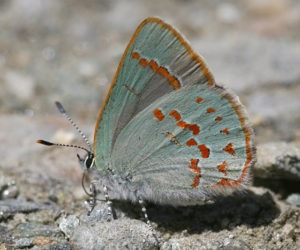
The early hairstreak (Erora laeta) is a small butterfly native to Kentucky. It is only a little less than an inch from the tip of one outstretched wing to the tip of the other outstretched wing. In other words, its wings would barely cover from the tip of your thumb to your first knuckle. The underside of its wings is a pale blue-green to grey with some orange dots. Since it often rests with its wings closed, this is the most common view of the early hairstreak. However, when the early hairstreak opens its wings, they are a deep blue and black.
Early hairstreaks live in mature forests that have a strong beech component. They spend much of their time in the tree canopy and only come down to the ground to feed or to obtain moisture and nutrients from damp soil. The adult females lay their eggs on the fruit of American beech (Fagus grandifolia). If American beech are not present, then they will lay their eggs on beaked hazelnuts (Corylus cornuta), but American beech is preferred. Early hairstreak caterpillars can only eat the fruit of American beech and beaked hazelnuts – they can’t survive on anything else. Immature early hairstreaks will overwinter as a pupae in the leaf litter at the base of the tree.
The early hairstreak has a wide range but isn’t common anywhere within that range. It is considered rare with localized populations. The early hairstreak is often called one of the rarest butterflies in its range. According to the Society of Kentucky Lepidopterists, it hasn’t been documented in Kentucky since 1989. Since it rarely comes to the ground, it may be more common than we know or it may be even rarer than we think it is. If you think you see one, please take lots of pictures, document where you saw it, and report your finding. If you aren’t sure who to tell, then contact me and I’ll help you get in touch with the appropriate people. This is one of those instances where there is still much to learn about one of our Kentucky pollinators.

This article was part of Shannon’s original Kentucky Pollinators and Backyard Wildlife blog which evolved into the blog for Backyard Ecology.

Backyard Ecology: Exploring Nature in Your Backyard
Nature isn’t just “out there.” It’s all around us, including right outside our doors. Hi, my name is Shannon Trimboli, and I am the host of Backyard Ecology. I live in southcentral Kentucky and am a wildlife biologist, educator, author, beekeeper, and owner of a nursery specializing in plants for pollinators and wildlife conservation. I invite you to join me as we ignite our curiosity and natural wonder, explore our yards and communities, and improve our local pollinator and wildlife habitat. Learn more or subscribe to my email list at www.backyardecology.net.

Leave a Reply